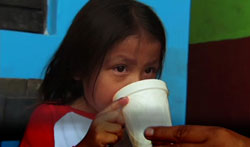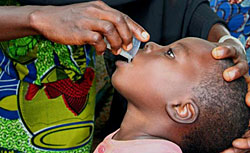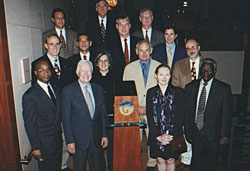The Carter Center’s health programs enabled a record 35.8 million treatments in 2010 to protect against neglected tropical diseases (NTDs) in thousands of communities in some of the most remote and forgotten places in Africa and the Americas.
Since 1986, The Carter Center has been a leader in the control, elimination, and eradication of neglected diseases, working at the grassroots in partnership with ministries of health and low-resource communities to conduct health education and mass drug administration, and to develop health service infrastructure. The Carter Center’s 10 health programs are data-driven and seek to help fill gaps in health care, looking for opportunities to eliminate or eradicate diseases wherever possible, and to control diseases that cannot be completely eliminated. Center disease interventions currently address Guinea worm, river blindness, trachoma, lymphatic filariasis, schistosomiasis, and malaria.
The Carter Center conducts rigorous annual peer reviews and evaluations in conjunction with ministries of health from 14 countries and other partner organizations.
“We don’t just rely on increased treatment numbers to tell us our efforts are working to improve health. The Carter Center uses evidence-based practices to carefully evaluate whether our interventions are significantly reducing the burden of disease,” said Dr. Donald Hopkins, vice president of the Carter Center’s Health Programs.
The 2010 statistics confirm dramatic improvements in public health achieved as a direct result of the Center’s disease efforts in partner countries.
2010 Achievements
The Carter Center-led campaign to wipe out Guinea worm disease (dracunculiasis) celebrated Nigeria and Niger’s elimination, and Ghana soon will be the next country to stop transmission.
 |
Nigeria, Niger Receive Carter Center Awards for Guinea Worm Eradication > |
| Ecuador joined Colombia as one of only two countries in history to halt transmission of river blindness (onchocerciasis) through health education and semiannual mass distribution of Mectizan®. Only five of 13 original areas are believed to remain endemic in the campaign to eliminate this disease from the Western Hemisphere by 2015. | |
 |
Lovato: Ending Onchocerciasis in Ecuador > |
| Nigeria—the third most lymphatic filariasis-endemic country in the world—demonstrated that elimination of the debilitating disease is possible when it announced that one-third of districts in two states in Nigeria halted transmission and another one-third are about to. | |
 |
Group Brings Hope to Nigerians Disfigured by Swollen Limbs > |
| For the first time in Amhara Region, Ethiopia, the world’s most trachoma endemic area, more than 9 million treatments—covering half the population—were delivered during the intensive semiannual, weeklong mass drug administrations. In another milestone in 2010, trachoma control efforts were expanded in Nigeria with the distribution of the first Zithromax® treatment in the country’s history. | |
 |
First Treatment for Trachoma in Nigeria Goes to Young Patient > |
| In Sudan, the vast and isolated desert community of Abu Hamad was on the verge of proving that river blindness can be eliminated in Africa with currently available tools. | |
 |
Video Journal: Pioneering Approach Brings River Blindness To Brink of Elimination In Sudanese Community > |
| The Carter Center is one of few organizations assisting the Nigeria Ministry of Health to tackle schistosomiasis—a debilitating and preventable disease mainly impacting children—in the most endemic country in Africa. In 2010, 1,328,886 praziquanteltreatments were delivered. | |
 |
Learn more about the ITFDE’s October 2010 recommendations (PDF) > |
Reports and recommendations further detailing 2010 Health Programs achievements and updates on further progress in 2011 will be available on the Carter Center’s website.
Please sign up below for important news about the work of The Carter Center and special event invitations.